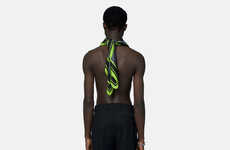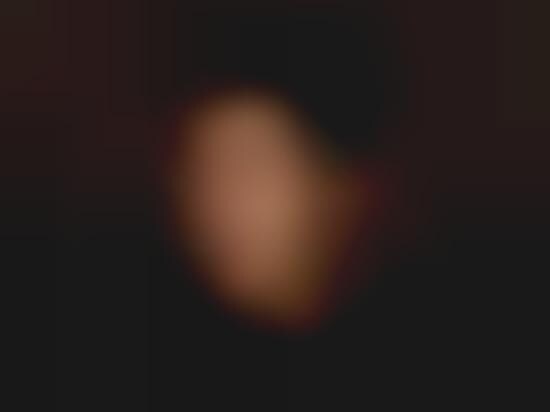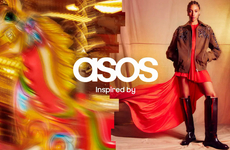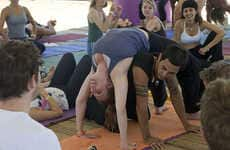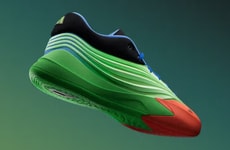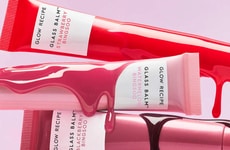
Brian G Randles — November 19, 2009 — Fashion
References: fashionindie
Daniel Saynt is the founder of the popular fashion blog Fashion Indie. His keen insight and quick humor allow him to remain on the forefront of the industry. Updates on celebrities, fashion and the always consuming topic of gossip, all are found on Fashion Indie.
As he has created one of the best fashion blogs on the web, we felt compelled to pick the brain of Daniel Saynt. Check out how Saynt stays ahead of the pack, and how trend hunting plays a role with Fashion Indie.
13 Questions with Daniel Saynt
1. How did you get involved in fashion and what motivates you to continue?
The Professional Reason: My mother was a model and designer for Norma Kamali and sparked my interest in the fashion industry at a very young age. In college I was Student Government President and engaged most with The Fashion Club, assisting them in fashion show creation. I studied Online Business and decided I would start a company that combined fashion and the web. I’m motivated by our continued growth and successes.
The Real Reason: In college, I really liked f*cking models. Today, I really like being surrounded by models.
2. How significant are the topics of cool hunting and trend spotting in the world of fashion blogging?
The world’s greatest designers (Margiela, Jacobs, Lagerfeld, McQueen, Galliano) are the ultimate cool hunters. They always seem ahead of the hunt and can identify the trends that will most affect consumers. For fashion bloggers, knowing those trends is important, but identifying new ones from street style photos or just being in the NYC nightlife scene has a massive significance if you want to stay ahead of the trend. That’s why so much of our content is dedicated to Trends and Innovators.
3. How do you define a trend?
You try something crazy like tattooing a d*ck on your face. Everyone around you thinks it’s idiotic and stupid until someone else does it. Then a couple more people catch on and you’ve suddenly got 10 - 15 other dickheads walking around. Robert Pattinson decides to get a massive c*ck on his cheek and US Weekly has it on their front page. Now more and more people are tattooing meat and potatoes on their faces and it’s officially a trend.
Now a recap.
- A trend begins when someone trys something that others might think is ridiculous.
- Trends are picked up by a small group of early adopting, bleeding edgers.
- Trends eventually get attention by “social leaders” like celebrities.
- Trends get media attention which spreads the trend of the “social leader.”
- Everyone imitates
- Robert Pattinson is a d*ckhead.
Not all trends are as idiotic as tattooing a pen*s on your face, but I’m in fashion. In the past year we’ve dealt with Muppets, Lady Gaga, Fat Old People on the Runway, and 12 inch unwalkable, monster heels inspired by Lobster Claws. Trends in our world are borderline insane.
4. How do you define cool?
The opposite of warm? I don’t know. Cool is like style. In my industry, fashion is what’s defined, style is what’s not. Trends and Cool are like that. Trends are defined by what the trend is and its lifecycle, Cool isn’t easily defined because it’s based on perception and individual execution. A fanny pack might seem like the ultimate style no-no but on the right person and proper styling it’s cool. Defining cool for instance, is so not cool…
5. Do you need a culture of innovation to create something that is cool?
No, there is the undoubted power of classic cool. James Dean, Biker Jackets, Marlboro Reds, Pre-1970’s Mustangs. All cool. All classic. Innovation does bring new identifiers of cool such as the iPhone, Rock Band jam sessions with friends, HD Video Recording, YouTube Celebrity. But the classics will always remain. Maybe we just need to accept Iconic as a new definer in this language so that Cool can always remain innovative.
6. What is the best way to create an infectious idea, product or service?
2 Cups of Sex
3 Tablespoons of Violence
A Dash of Humor
Garnish with Free sh**
Mix in a bowl for 3 - 5 minutes for viral videos. Add creative team of “social leaders” for product or service launches.
Recipe doesn’t have to be in that order and can still bake a nice cake if one of the ingredients is missing.
7. What is the key to innovation?
Using your f*cking brain for doing more than rudimentary things like giving parking tickets. I hate Meter Maids. They are worse than Colombian druglords, ‘cause at least druglords have to use their brain occasionally come up with creative ways to get Americans their cocaine. Meter Maids just walk the earth to make life miserable and are therefore in my mind only slightly better than Hitler.
The key to innovation is thinking. Everyone in America needs to spend more time thinking than doing. We all need to just sit down in a dark room, close our eyes, and quietly think for 30 minutes to an hour. Innovation comes from working minds and right now we’re getting by with too many people not using theirs.
So the key is to just do it. If you can’t think innovatively, consider yourself a moron, save us any trouble of having to interact with you in real life and become a meter maid.
8. What are the most important trends you see in the fashion industry?
Here are the ones I’m pushing for.
- Better incorporation of innovative fabrics on the runway. If someone’s paying 3,000 for a dress, it should at least fly, or maybe just never need to be dry cleaned.
- Just In Time Production Schedules. The clothing is available when it hits the runway, not 6 months later.
- Creativity Incubators. Designers partnering with other creatives such as graphic designers, artists, web designers, students, and journalists to create original content and fashions. We need more creative people connecting together to rethink the way we’ve done business in the past.
- Death to Print. It’s happening faster than magazines realize and new technologies like full color, high definition video enabled readers are going to destroy the industry in 2010 - 2011. I expect more firings, saying goodbye to lesser known publications, and a transition to new technology and the web where the playing field is level and I’m already ahead of the game.
9. What are your ambitions for Fashion Indie?
Immediate: To secure more readers than WWD.com, Elle.com and Style.com (in that order). This week we’ll close in on WWD (Womens Wear Daily), we expect to hit Elle’s numbers by March/April and Style.com within a year.
Future: To be the most read fashion & beauty publication with global reach in every language. To create a Fashion Island of the Coast of the Mediterranean. To enjoy picking who gets to come.
Overall growth is our big focus. We’ve never taken investment funding and are now looking for investors. It’s a scary time with the economy and all, but fortunately we’re making enough to be self suffient and continue to build. We have three potential investors who are dedicated to the industry we’re in which is really great.
We’re also launching new projects to keep us ahead including aggregators for Fashion Videos, Tweets and Facebook Updates. Plus, we have CultIndie.com, a semi-private network for industry leaders which just hit 6000 members.
10. What is an example of a time where you have thrown away an existing idea to force yourself to find something new?
I’m never satisfied with an idea and everything can be better. I’m always tinkering and improving. As for starting completely new, it happens occasionally, especially when dealing with events. Our events are often underfunded, so we come up with amazing ideas but then need to start from the beginning to keep them at budget. It sucks and I hate that. It’s a bad feeling to be controlled by money, but that’s usually what kills innovation and ideas.
11. How do you reset yourself to be creative? Do you have any rituals?
I haven’t changed my socks since starting Fashion Indie. No, Um, I just am creative. Ideas come to me when I give myself the time to be alone in my thoughts. I think that’s why I love Internet p*rn so much. It’s mind numbing entertainment that gives you a good 5 - 7 minutes (longer if I really, really needed to think and I had the afternoon free from the missus) to be alone with your thoughts in a completely relaxed state. I’ve come up with my best ideas while wanking to college coeds.
12. Professionally, what do you want to be doing or studying in 10 years?
Photography as an art form has gone largely untapped and new technology and photo editing software is making the impossible possible in both video and sound. I want to become a professional photographer who uses to Hollywood standard editing to create moving vignettes that merge fashion, eroticism, and Pop Culture to create a new standard in fine art and photography. What I’m doing now is helping to get me closer to this goal.
13. What are your most important hobbies?
Spelunking. Backyard Wresting. Collecting One Minute Videos of Friends & Acquaintances.
As he has created one of the best fashion blogs on the web, we felt compelled to pick the brain of Daniel Saynt. Check out how Saynt stays ahead of the pack, and how trend hunting plays a role with Fashion Indie.
13 Questions with Daniel Saynt
1. How did you get involved in fashion and what motivates you to continue?
The Professional Reason: My mother was a model and designer for Norma Kamali and sparked my interest in the fashion industry at a very young age. In college I was Student Government President and engaged most with The Fashion Club, assisting them in fashion show creation. I studied Online Business and decided I would start a company that combined fashion and the web. I’m motivated by our continued growth and successes.
The Real Reason: In college, I really liked f*cking models. Today, I really like being surrounded by models.
2. How significant are the topics of cool hunting and trend spotting in the world of fashion blogging?
The world’s greatest designers (Margiela, Jacobs, Lagerfeld, McQueen, Galliano) are the ultimate cool hunters. They always seem ahead of the hunt and can identify the trends that will most affect consumers. For fashion bloggers, knowing those trends is important, but identifying new ones from street style photos or just being in the NYC nightlife scene has a massive significance if you want to stay ahead of the trend. That’s why so much of our content is dedicated to Trends and Innovators.
3. How do you define a trend?
You try something crazy like tattooing a d*ck on your face. Everyone around you thinks it’s idiotic and stupid until someone else does it. Then a couple more people catch on and you’ve suddenly got 10 - 15 other dickheads walking around. Robert Pattinson decides to get a massive c*ck on his cheek and US Weekly has it on their front page. Now more and more people are tattooing meat and potatoes on their faces and it’s officially a trend.
Now a recap.
- A trend begins when someone trys something that others might think is ridiculous.
- Trends are picked up by a small group of early adopting, bleeding edgers.
- Trends eventually get attention by “social leaders” like celebrities.
- Trends get media attention which spreads the trend of the “social leader.”
- Everyone imitates
- Robert Pattinson is a d*ckhead.
Not all trends are as idiotic as tattooing a pen*s on your face, but I’m in fashion. In the past year we’ve dealt with Muppets, Lady Gaga, Fat Old People on the Runway, and 12 inch unwalkable, monster heels inspired by Lobster Claws. Trends in our world are borderline insane.
4. How do you define cool?
The opposite of warm? I don’t know. Cool is like style. In my industry, fashion is what’s defined, style is what’s not. Trends and Cool are like that. Trends are defined by what the trend is and its lifecycle, Cool isn’t easily defined because it’s based on perception and individual execution. A fanny pack might seem like the ultimate style no-no but on the right person and proper styling it’s cool. Defining cool for instance, is so not cool…
5. Do you need a culture of innovation to create something that is cool?
No, there is the undoubted power of classic cool. James Dean, Biker Jackets, Marlboro Reds, Pre-1970’s Mustangs. All cool. All classic. Innovation does bring new identifiers of cool such as the iPhone, Rock Band jam sessions with friends, HD Video Recording, YouTube Celebrity. But the classics will always remain. Maybe we just need to accept Iconic as a new definer in this language so that Cool can always remain innovative.
6. What is the best way to create an infectious idea, product or service?
2 Cups of Sex
3 Tablespoons of Violence
A Dash of Humor
Garnish with Free sh**
Mix in a bowl for 3 - 5 minutes for viral videos. Add creative team of “social leaders” for product or service launches.
Recipe doesn’t have to be in that order and can still bake a nice cake if one of the ingredients is missing.
7. What is the key to innovation?
Using your f*cking brain for doing more than rudimentary things like giving parking tickets. I hate Meter Maids. They are worse than Colombian druglords, ‘cause at least druglords have to use their brain occasionally come up with creative ways to get Americans their cocaine. Meter Maids just walk the earth to make life miserable and are therefore in my mind only slightly better than Hitler.
The key to innovation is thinking. Everyone in America needs to spend more time thinking than doing. We all need to just sit down in a dark room, close our eyes, and quietly think for 30 minutes to an hour. Innovation comes from working minds and right now we’re getting by with too many people not using theirs.
So the key is to just do it. If you can’t think innovatively, consider yourself a moron, save us any trouble of having to interact with you in real life and become a meter maid.
8. What are the most important trends you see in the fashion industry?
Here are the ones I’m pushing for.
- Better incorporation of innovative fabrics on the runway. If someone’s paying 3,000 for a dress, it should at least fly, or maybe just never need to be dry cleaned.
- Just In Time Production Schedules. The clothing is available when it hits the runway, not 6 months later.
- Creativity Incubators. Designers partnering with other creatives such as graphic designers, artists, web designers, students, and journalists to create original content and fashions. We need more creative people connecting together to rethink the way we’ve done business in the past.
- Death to Print. It’s happening faster than magazines realize and new technologies like full color, high definition video enabled readers are going to destroy the industry in 2010 - 2011. I expect more firings, saying goodbye to lesser known publications, and a transition to new technology and the web where the playing field is level and I’m already ahead of the game.
9. What are your ambitions for Fashion Indie?
Immediate: To secure more readers than WWD.com, Elle.com and Style.com (in that order). This week we’ll close in on WWD (Womens Wear Daily), we expect to hit Elle’s numbers by March/April and Style.com within a year.
Future: To be the most read fashion & beauty publication with global reach in every language. To create a Fashion Island of the Coast of the Mediterranean. To enjoy picking who gets to come.
Overall growth is our big focus. We’ve never taken investment funding and are now looking for investors. It’s a scary time with the economy and all, but fortunately we’re making enough to be self suffient and continue to build. We have three potential investors who are dedicated to the industry we’re in which is really great.
We’re also launching new projects to keep us ahead including aggregators for Fashion Videos, Tweets and Facebook Updates. Plus, we have CultIndie.com, a semi-private network for industry leaders which just hit 6000 members.
10. What is an example of a time where you have thrown away an existing idea to force yourself to find something new?
I’m never satisfied with an idea and everything can be better. I’m always tinkering and improving. As for starting completely new, it happens occasionally, especially when dealing with events. Our events are often underfunded, so we come up with amazing ideas but then need to start from the beginning to keep them at budget. It sucks and I hate that. It’s a bad feeling to be controlled by money, but that’s usually what kills innovation and ideas.
11. How do you reset yourself to be creative? Do you have any rituals?
I haven’t changed my socks since starting Fashion Indie. No, Um, I just am creative. Ideas come to me when I give myself the time to be alone in my thoughts. I think that’s why I love Internet p*rn so much. It’s mind numbing entertainment that gives you a good 5 - 7 minutes (longer if I really, really needed to think and I had the afternoon free from the missus) to be alone with your thoughts in a completely relaxed state. I’ve come up with my best ideas while wanking to college coeds.
12. Professionally, what do you want to be doing or studying in 10 years?
Photography as an art form has gone largely untapped and new technology and photo editing software is making the impossible possible in both video and sound. I want to become a professional photographer who uses to Hollywood standard editing to create moving vignettes that merge fashion, eroticism, and Pop Culture to create a new standard in fine art and photography. What I’m doing now is helping to get me closer to this goal.
13. What are your most important hobbies?
Spelunking. Backyard Wresting. Collecting One Minute Videos of Friends & Acquaintances.
Trend Themes
1. Fashion Blogging - Disruptive innovation opportunity: Incorporating new technologies like full color, high definition video and interactive features in fashion blogging to attract a larger audience.
2. Innovative Fabrics - Disruptive innovation opportunity: Developing and incorporating innovative fabrics in clothing that offer unique features, such as self-cleaning or self-repairing properties.
3. Just in Time Production - Disruptive innovation opportunity: Implementing just-in-time production schedules in the fashion industry to reduce waste and improve supply chain efficiency.
Industry Implications
1. Fashion Industry - Disruptive innovation opportunity: Collaborating with graphic designers, artists, web designers, students, and journalists to create original content and fashions.
2. Publishing Industry - Disruptive innovation opportunity: Embracing new technologies and transitioning to digital platforms to stay competitive in the changing media landscape.
3. Photography Industry - Disruptive innovation opportunity: Utilizing new technology and photo editing software to create unique and creative fine art and photography pieces that merge fashion, eroticism, and pop culture.
2.3
Score
Popularity
Activity
Freshness


